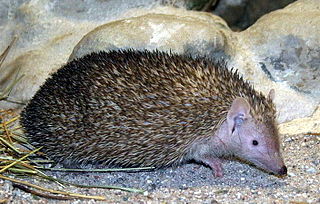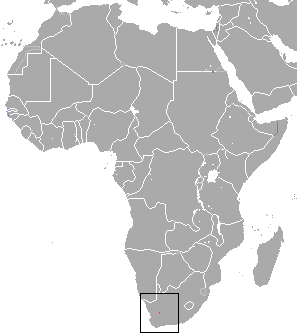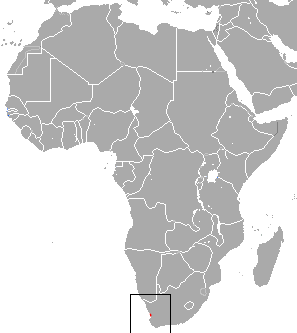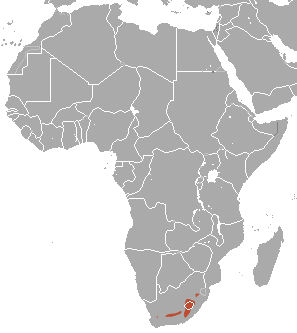
Golden moles are small insectivorous burrowing mammals endemic to Sub-Saharan Africa. They comprise the family Chrysochloridae and as such they are taxonomically distinct from the true moles, family Talpidae, and other mole-like families, all of which, to various degrees, they resemble as a result of evolutionary convergence. There are 21 species. Some are relatively common, whereas others are rare and endangered.

The clade Afrosoricida contains the golden moles of Southern Africa, the otter shrews of equatorial Africa and the tenrecs of Madagascar. These three groups of small mammals were for most of the 19th and 20th centuries regarded as a part of the Insectivora or Lipotyphla, but both of those groups, as traditionally used, are polyphyletic.

Juliana's golden mole is a golden mole endemic to South Africa. It is listed as an endangered species due to habitat loss and a restricted range. Golden moles are an ancient group of mammals that live mostly below ground. The eponymous Juliana is Juliana Meester, the wife of the South African zoologist who named this species.

Visagie's golden mole is a small, insectivorous mammal of the family Chrysochloridae, the golden moles, endemic to South Africa.

Van Zyl's golden mole is a golden mole endemic to the Western Cape Province, South Africa. It is listed as an endangered species due to habitat loss. Golden moles are an ancient group of mammals who live mostly below ground. They have shiny coats of dense fur and a streamlined, formless appearance. They have no visible eyes or ears; in fact, they are blind – the small eyes are covered with hairy skin. The ears are small and are hidden in the animal's fur.

The giant golden mole is a small mammal found in Africa. At 23 centimetres (9.1 in) in length, it is the largest of the golden mole species. The mole has dark, glossy brown fur; the name golden comes from the Greek word for green-gold, the family Chrysochloridae name.

The fynbos golden mole is a species of mammal in the golden mole family, Chrysochloridae. It is endemic to South Africa.
Amblysomus is a genus of the golden mole family, Chrysochloridae, comprising five species of the small, insect-eating, burrowing mammals endemic to Southern Africa. All five species can be found in South Africa and some are also found in Eswatini and Lesotho.

The Hottentot golden mole is a species of mammal in the golden mole family, Chrysochloridae. It is found in South Africa, Eswatini, and possibly Lesotho. Its natural habitats are temperate forests, subtropical or tropical dry and moist lowland forest and dry shrubland and grassland, Mediterranean-type shrubby vegetation, savanna, temperate grassland, sandy shores, arable land, pastureland, plantations, rural gardens, and urban areas.

Marley's golden mole is a species of burrowing mammal in the golden mole family, Chrysochloridae. It is found in South Africa and possibly Eswatini. It has been separated from Amblysomus hottentotus by Bronner. Its natural habitat is indigenous forests and moist grassland, and also gardens. It is classified as Endangered in the IUCN Red List of Threatened Species. The main threats it faces are habitat degradation, either through overgrazing by cattle or the removal of vegetation for firewood, and urbanization.

The robust golden mole is a species of mammal in the golden mole family, Chrysochloridae. It is endemic to parts of Mpumalanga province in South Africa. Its natural habitats are temperate forests, subtropical or tropical moist lowland forest, temperate and subtropical or tropical dry shrubland, dry lowland grassland, arable land, pastureland, plantations, rural gardens, and urban areas.

The highveld golden mole is a species of mammal in the golden mole family, Chrysochloridae. It is found in South Africa and Eswatini. Its natural habitats are forests, moist savanna, temperate shrubland and grassland, subtropical or tropical dry lowland grassland, arable land, pastureland, plantations, rural gardens, and urban areas.

The yellow golden mole is a species of mammal in the family Chrysochloridae. It is found in Mozambique, South Africa, and Zimbabwe. The yellow golden mole's natural habitats are subtropical or tropical dry and moist lowland forests, savanna, arable land, pasture, plantations, and rural gardens.
Duthie's golden mole is a species of mammal in the family Chrysochloridae. It is endemic to South Africa. Its natural habitats are subtropical or tropical moist lowland forests, moist savanna, temperate grassland, arable land, pastureland, plantations, rural gardens, and urban area. The specific name duthieae was given in honour of Dr. Augusta Vera Duthie, a South African botanist.

Sclater's golden mole is a species of mammal in the family Chrysochloridae. It is found in Lesotho and South Africa. Its natural habitats are subtropical or tropical dry and high-altitude shrubland, Mediterranean-type shrubby vegetation, temperate grassland, arable land, pastureland, rural gardens, and urban areas. This species is locally common, and the International Union for Conservation of Nature has assessed its conservation status as being of "least concern".

Stuhlmann's golden mole is a species of mammal in the family Chrysochloridae. It is found in Cameroon, Democratic Republic of the Congo, Kenya, Tanzania, and Uganda. Its natural habitats are subtropical or tropical moist montane forest and high-elevation shrubland, Mediterranean-type shrubby vegetation, subtropical or tropical dry grassland, arable land, and pasture.

De Winton's golden mole is a species of mammal in the family Chrysochloridae. It is endemic to South Africa. Its natural habitats are subtropical dry shrubland, Mediterranean-type shrubby vegetation, and sandy shores. It is threatened by habitat destruction and is "critically endangered". It was named after British zoologist William Edward de Winton.

The red rock hares are the four species in the genus Pronolagus. They are African lagomorphs of the family Leporidae.
















